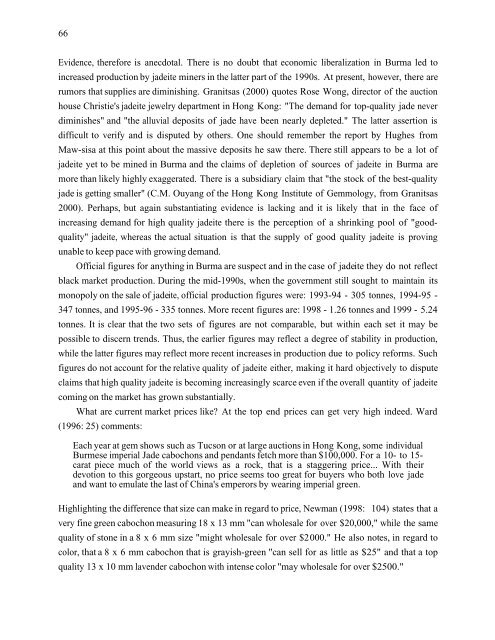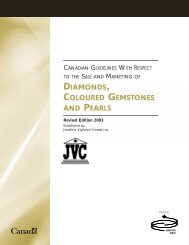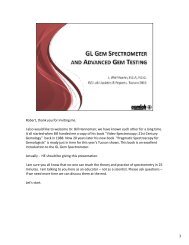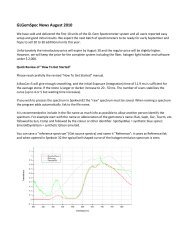JADEITE - Canadian Institute of Gemmology
JADEITE - Canadian Institute of Gemmology
JADEITE - Canadian Institute of Gemmology
Create successful ePaper yourself
Turn your PDF publications into a flip-book with our unique Google optimized e-Paper software.
66<br />
Evidence, therefore is anecdotal. There is no doubt that economic liberalization in Burma led to<br />
increased production by jadeite miners in the latter part <strong>of</strong> the 1990s. At present, however, there are<br />
rumors that supplies are diminishing. Granitsas (2000) quotes Rose Wong, director <strong>of</strong> the auction<br />
house Christie's jadeite jewelry department in Hong Kong: "The demand for top-quality jade never<br />
diminishes" and "the alluvial deposits <strong>of</strong> jade have been nearly depleted." The latter assertion is<br />
difficult to verify and is disputed by others. One should remember the report by Hughes from<br />
Maw-sisa at this point about the massive deposits he saw there. There still appears to be a lot <strong>of</strong><br />
jadeite yet to be mined in Burma and the claims <strong>of</strong> depletion <strong>of</strong> sources <strong>of</strong> jadeite in Burma are<br />
more than likely highly exaggerated. There is a subsidiary claim that "the stock <strong>of</strong> the best-quality<br />
jade is getting smaller" (C.M. Ouyang <strong>of</strong> the Hong Kong <strong>Institute</strong> <strong>of</strong> <strong>Gemmology</strong>, from Granitsas<br />
2000). Perhaps, but again substantiating evidence is lacking and it is likely that in the face <strong>of</strong><br />
increasing demand for high quality jadeite there is the perception <strong>of</strong> a shrinking pool <strong>of</strong> "good-<br />
quality" jadeite, whereas the actual situation is that the supply <strong>of</strong> good quality jadeite is proving<br />
unable to keep pace with growing demand.<br />
Official figures for anything in Burma are suspect and in the case <strong>of</strong> jadeite they do not reflect<br />
black market production. During the mid-1990s, when the government still sought to maintain its<br />
monopoly on the sale <strong>of</strong> jadeite, <strong>of</strong>ficial production figures were: 1993-94 - 305 tonnes, 1994-95 -<br />
347 tonnes, and 1995-96 - 335 tonnes. More recent figures are: 1998 - 1.26 tonnes and 1999 - 5.24<br />
tonnes. It is clear that the two sets <strong>of</strong> figures are not comparable, but within each set it may be<br />
possible to discern trends. Thus, the earlier figures may reflect a degree <strong>of</strong> stability in production,<br />
while the latter figures may reflect more recent increases in production due to policy reforms. Such<br />
figures do not account for the relative quality <strong>of</strong> jadeite either, making it hard objectively to dispute<br />
claims that high quality jadeite is becoming increasingly scarce even if the overall quantity <strong>of</strong> jadeite<br />
coming on the market has grown substantially.<br />
What are current market prices like? At the top end prices can get very high indeed. Ward<br />
(1996: 25) comments:<br />
Each year at gem shows such as Tucson or at large auctions in Hong Kong, some individual<br />
Burmese imperial Jade cabochons and pendants fetch more than $100,000. For a 10- to 15carat<br />
piece much <strong>of</strong> the world views as a rock, that is a staggering price... With their<br />
devotion to this gorgeous upstart, no price seems too great for buyers who both love jade<br />
and want to emulate the last <strong>of</strong> China's emperors by wearing imperial green.<br />
Highlighting the difference that size can make in regard to price, Newman (1998: 104) states that a<br />
very fine green cabochon measuring 18 x 13 mm "can wholesale for over $20,000," while the same<br />
quality <strong>of</strong> stone in a 8 x 6 mm size "might wholesale for over $2000." He also notes, in regard to<br />
color, that a 8 x 6 mm cabochon that is grayish-green "can sell for as little as $25" and that a top<br />
quality 13 x 10 mm lavender cabochon with intense color "may wholesale for over $2500."









